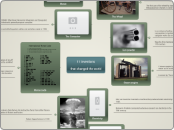Universal Design Theory and Understanding By Design
The inventor of Eisenhower Matrix is Dwight David Eisenhower – an American army general and statesman who served as the 34th President of the United States from 1953 to 1961. His method helps us prioritize by urgency and importance.
Using Technology
These tasks are not important but they still need to be done. The question you have to address yourself: Who can do this for you?
Class lectures, notes, assignments can be viewed at the students own pace and on their own time if they choose, eliminating the "ticking clock"
Videos, podcasts, blog posts, wiki pages can all be used as alternative forms of assessments
Students can choose how to best utilize these tools based on their interests and needs to complete lesson objectives
Teachers can use different websites, digital aids and technology to teach the same lesson to different students with different needs i.e. Autism, ELL, Dyslexia, Discalculia
The Barriers
Tasks that are not urgent nor important should be eliminated so you will not waste time doing them.
Not Having Enough Support Staff
Improper or Rushed Evalutation
One Size Fits All Approach
Standardized Assessments
Utilizing 21st Century Skills
By having students work in partners or groups with ELL's, and students with SLD's they are learning tolerance, acceptance and adaptability
An inclusive classroom exposes students to diversity, different cultures and to people who think and act differently than them
Fosters creativity and problem solving skills by allowing students to choose how they want to be assessed, which helps develop self-efficacy
Student centered learning encourages collaboration, communication and teamwork
Encourage individual choice and autonomy
Provides All Students Access to General Curriculum
These tasks are still important but they're not urgent so you can schedule a time to do them.
Addresses the individual learner and their needs
Utilizes alternative forms of assessments that are more inclusive
Uses graduated levels of support for practice and performance. Scaffolding
Provides different means of action/expression, uses multiple media for communication
Encourages multiple means of content representation
The Theories
Urgent and Important tasks that need to be done now.
Provide complex authentic opportunities for students to explain, interpret, apply, shift perspective, and self-assess
Accurately assess knowledge development
Connect to prior knowledge then use different methods to build knowledge, such as visual, audio, graphic, kinetic, text
Present the material in varied ways
First Define Objectives/goals then plan assessments









